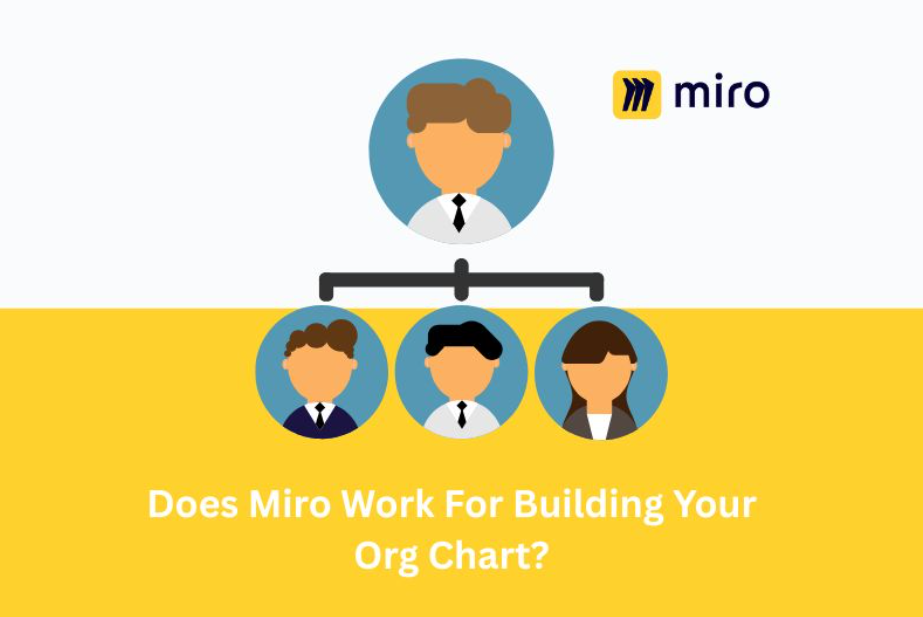Does Miro Work For Building Your Org Chart?
Wondering if Miro is the right tool for building your org chart? Discover the pros, cons, and best practices for using Miro to design effective organizational charts.

Miro can be used to build your org chart. In fact, it’s a valuable tool for showcasing organizational hierarchy, and with the addition of their org chart widget, it is fast becoming a good alternative to Excel, PowerPoint, Google Slides, and Google Docs for creating a visual representation of your company’s structure.
So, it’s a pretty good option for org charts, and we’ll take you through the reasons why. However, there are also better apps for building your company’s organizational chart that can be integrated with communication tools such as Slack. We’ll take a look at one of these apps too, and explain why you might want to move your org chart to the same platform that you already spend all your time in.
Why are org charts important?
In the days when it was just you and a handful of employees, an Excel org chart might have worked just fine, but let’s face it, once the company grows rapidly, an Excel chart becomes a nightmare.
Resource allocation is messy, and you can no longer see the broader picture. New employees look at your complicated Excel chart and decide not to bother, and your HR is no longer interested in spending all their time fixing it.
That’s when it hits you - this is not working. You need something better and fast!
Enter Miro. A collaborative and free way to keep new team members in the loop, HR happy, and the organization’s hierarchy up-to-date.
Understanding the different types of org charts
Before you create your org chart, it’s important that you understand there are different types of org charts.
This matters because each type represents how decisions are made, how communication flows, and who collaborates with whom in distributed teams. It also helps you choose the right template in Miro.
- Hierarchical org chart: Best to visualize a hierarchical structure and top-down organizational design.
- Matrix org chart: Good for cross-functional teams working on multiple projects.
- Circular org chart: Excellent for visualizing interconnected working relationships and team structures, such as those in a start-up or sales teams.
- Collaborative org chart: Focuses on how people work together across projects. Perfect for a remote team.
Why collaborate when designing your org chart?
Collaboration tools like Miro are ideal for teams with multiple users in different geographical locations.
Team collaboration can be challenging for remote teams, but Miro makes it easier by providing a platform for working together on projects and sharing relevant information.
Even if your human resource team is based in different countries, Miro allows each team member to classify their region’s structures correctly. This is a more effective way to demonstrate meaningful connections between team members, departments, projects, and roles.
Key Miro features useful for org charts
Miro board has a number of features that are useful for generating org charts and collaborating on their design. You can use the AI org chart maker and other intuitive design tools to turn your org chart into a useful, dynamic, and valuable business tool.
1. Infinite canvas
One of the major benefits of Miro over Excel or Google Slides is that it has an infinite whiteboard, making the space available limitless.
You can think of it as an endless digital whiteboard where teams can ‘pop in’ to ideate, plan, and design in real-time. The infinite whiteboard makes it a good choice for large and complex organizational structures or accountability charts.
2. Customizable templates
An extensive number of pre-created chart templates provide you with any layout or org chart type that you require.
Users can utilize the dedicated org chart tool to create a dynamic org chart, starting from a basic template, and easily modify reporting relationships and the organization’s structure.
Getting together to work on the org structure? Team members can choose from multiple templates and then work on how it best represents organizational data.
3. Smart diagramming tools, collaborative editing, and importing files
Creating org charts in Miro is easy and simple with a ‘drop-and-drag’ shapes tool (rectangles, circles, lines, and arrows), and connectors that snap to objects and show relationships.
Bring people together on the board to discuss, give feedback, and work jointly on org charts to ensure everyone agrees on the direction and strategy. With real-time data and collaborative tools, you can ensure your organization’s resources are allocated efficiently to meet both current and future needs.
Create or update a chart using CSV files that you’ve created using Excel or Google Sheets. You can do this using the ‘import CSV’ button.
4. Integration with other tools and version history
Miro integrates with popular everyday apps like Slack, Microsoft Teams, Google Drive, Notion, Asana, and Jira, making it a perfect partner to apps you already love. Miro org charts can also be embedded into website pages or exported as a PDF or PNG for sharing.
How to create an organizational chart in Miro
If you’re still with us, you must think that Miro is an option worth considering for your org charts. In that case, let’s work together on creating a basic org chart in Miro.
Create an org chart
- Open a blank Miro board.
- Go to the creation toolbar on the left-hand side of your board.
- Click on ‘more apps’ (+) and search ‘org chart’ or go to the AI button at the top of the creation toolbar.
- Click on ‘org chart’ to create a draft org chart, which you can customize. Miro will automatically process your data and fill in your org chart accordingly.
Edit the org chart
- Reassign roles and reporting lines by rearranging cards. You do this by clicking the card and moving it to where you want it.
- To add more cards, click the + icon surrounding the existing card. Keep doing this until you have all the cards you need.
- Double-click the card’s text to edit name, role, team, direct reports, or location.
- To show or hide specific information, click the context menu and choose the filter icon. Then, use the selection boxes to filter according to team, location, or any other custom field.
If you’re not keen on building an organizational chart from the ground up, then navigate to the templates section and choose a ready-made org chart template. Miro will provide you with a wide variety of expertly crafted charts, tailored to match your business structure perfectly.
Miro limitations
As powerful as it is, Miro is not a dedicated organizational chart app. This means:
- Lack of automation features: Miro cannot pull employee data from existing platforms like Slack and your ERP. You will need to manually update information.
- Search function is lacking: There is no central directory, so you will spend your time filtering out information, scrolling, zooming, and clicking around.
- Not ideal for HR: There’s no built-in support for performance tracking or user data. You’ll need other tools for that.
- It isn’t a Slack first design: If your team lives in Slack, you’ll still be toggling between platforms.
If any of these limitations bother you, you need a better alternative to Miro, especially if you spend all your time in Slack (HRs - we feel your pain).
Luckily, there is an alternative that not only has a Slack-first design but also provides the features that Miro can’t. If you want an automated, Slack-friendly, powerful org chart app, keep reading. 👇
Linky Directory: A Miro alternative for org charts
Right, let’s just get to the point and tell you what Linky Directory can do for you that Miro can’t.
- Build your org chart in seconds. No messing around with shapes.
- Store any employee data you want by customizing employee profiles.
- Visualize hierarchies, teams, project members, gaps in resources, and vacancies.
- Adapt teams and employee information quickly and easily.
- Give your newbies a clear view of your organization and reporting lines.
- Get your org chart automatically updated when someone leaves or joins the company.
- Ping employees in Slack when you’re missing important information.
- Have an advanced search function at your fingertips.
- Get Linky Directory in just three steps. Click, click, click - seriously. That’s it!
If you’re ready to build your org chart in seconds, then get started right now. It’s so easy, you don’t even need to think about what to do.
Psst. Here’s a bonus for you. If you have 10 users or less, you can install the entire BuddiesHR suite of apps, including Billy Birthday, Alfy Matching, and Clappy Kudos - our most popular ‘buddies’ in Slack.
Wrap Up
If you’re looking for a smart collaborative whiteboard that you can use to create your org chart, then Miro absolutely delivers. If, however, you need a powerful org chart tool that lives in Slack, then Linky Directory is the smart choice. It turns your org structure from static to dynamic. So, while Miro is a good start, why not just level up with Linky?




